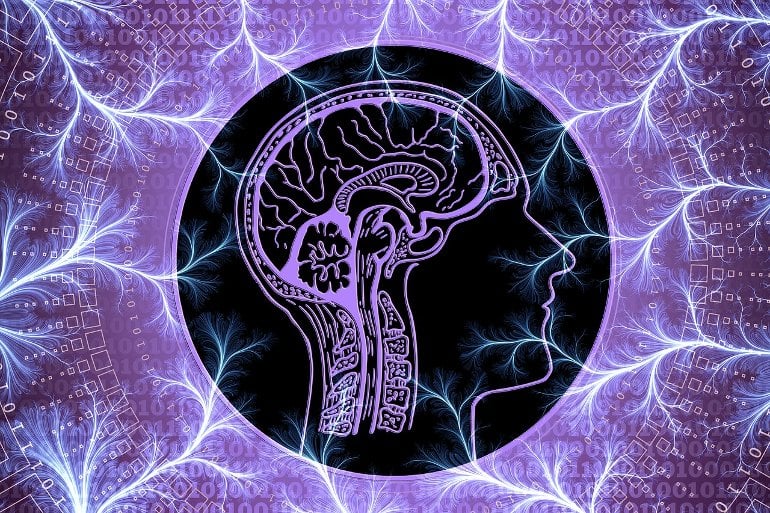Summary: The severity of PTSD symptoms was associated with fewer risky choices and increased activation of the amygdala. Decreased activity in the ventral striatum, an area of the brain associated with processing positive valence such as reward, predicted more severe PTSD symptoms 14 months post-trauma.
Source: Elsevier
For many people, a traumatic experience can leave an indelible impression on the brain in the form of post-traumatic stress disorder (PTSD). PTSD is characterized by hyperarousal and avoidance of risky, potentially aversive behaviors.
Research has revealed that the brain employs distinct circuitries that mediate positive, or rewarding, behaviors and negative, or aversive, ones. PTSD has long been thought to arise from overactivity in the negative valence system, however a new study shows that people with PTSD also displayed a deficit in activation of positive valence processing soon after the trauma, suggesting it plays a role in resilience to PTSD.
The work appears in Biological Psychiatry: Cognitive Neuroscience and Neuroimaging.
Led by Talma Hendler, MD, PhD, and Ziv Ben-Zion, PhD, both at Tel Aviv University, Israel, the researchers identified 171 people who had been treated in a hospital emergency department for a trauma (such as a car accident) and who, within two weeks of the traumatic event, were experiencing symptoms of PTSD.
One month after the trauma, survivors were assessed in the lab by a trained clinical interviewer in more detail, and underwent brain scans by functional magnetic resonance imaging (fMRI). The same assessments were made at six months and 14 months post-trauma.
While undergoing fMRI, participants played a competitive electronic gambling game designed to test participants’ sensitivity to risk, reward and punishment.
Not surprisingly, participants with more severe PTSD symptoms at the start of the study made fewer risky choices in the game, and fMRI scans showed that they had greater activation in the amygdala—a brain region associated with fear processing and a key part of the negative valence system.
But decreased activity at one month in the ventral striatum, a mesolimbic brain region involved in processing positive valence like rewards, predicted more severe PTSD symptoms at 14 months.
Dr. Ben-Zion said the work “provides insights on roles of both the positive and negative valence processing systems in the early development of post-traumatic psychopathology. While most of the research to date on stress and trauma has focused on the hyper-active negative valence system (e.g., increased fear and threat responses), our findings also suggest a critical role for hypo-active positive valence system (e.g., less neural activation towards rewards) in PTSD development and point to its role in resilience to traumatic stress and /or adaptive recovery from it.”

Cameron Carter, MD, Editor of Biological Psychiatry: Cognitive Neuroscience and Neuroimaging, said, “This work provides new insights into the fundamental changes in brain function that follow traumatic experiences and underlie the development of PTSD. The study shows us that these changes go beyond dysregulated threat processing and include brain systems related to reward and motivation that are likely to underlie changes in mood and motivated behavior in PTSD.”
The work could have implications for therapeutic strategies to treat stress- and anxiety-related disorders, Professor Hendler said, adding that “novel therapeutic approaches should address both positive and negative valence systems, as these two are intrinsically linked and both affect the symptom development after experiencing traumatic stress.
“Furthermore, we suggest that specific deficits in each valence system are associated with specific symptoms of PTSD, possibly pointing to distinct underlying mental processes that could guide a more personalized approach in psychiatric treatment.”
About this PTSD research news
Author: Rhiannon Bugno
Source: Elsevier
Contact: Rhiannon Bugno – Elsevier
Image: The image is in the public domain
Original Research: Closed access.
“Neural Responsivity to Reward versus Punishment Shortly after Trauma Predicts Long-term Development of Post-Traumatic Stress Symptoms” by Talma Hendler, Ziv Ben-Zion et al. Biological Psychiatry: Cognitive Neuroscience and Neuroimaging
Abstract
Neural Responsivity to Reward versus Punishment Shortly after Trauma Predicts Long-term Development of Post-Traumatic Stress Symptoms
Background
Processing negative and positive valenced stimuli involve multiple brain regions including the amygdala and ventral striatum (VS). Post-Traumatic Stress Disorder (PTSD) is often associated with hyper-responsivity to negatively valenced, yet recent evidence also points to deficient positive valence functioning. It is yet unclear what is the relative contribution of such opposing valence processing shortly after trauma to the development of chronic PTSD.
Methods
Neurobehavioral indicators of motivational positive vs. negative valence sensitivities were longitudinally assessed in 171 adults (87 females, age=34.19±11.47 years) at 1-, 6-, and 14-months following trauma exposure (TP1, TP2, TP3). Using a gambling fMRI paradigm, amygdala and VS functionality (activity and functional connectivity with the prefrontal cortex) in response to rewards vs. punishments were assessed with relation to PTSD severity at different time-points. The effect of valence processing was depicted behaviorally by the amount of risk taken to maximize reward.
Results
PTSD severity at TP1 was associated with greater neural functionality in the amygdala (but not the VS) towards punishments vs. rewards, and fewer risky choices. PTSD severity at TP3 was associated with decreased neural functionality in both the VS and amygdala towards rewards vs. punishments at TP1 (but not with risky behavior). Explainable machine learning revealed the primacy of VS biased processing, over the amygdala, in predicting PTSD severity at TP3.
Conclusions
These results highlight the importance of biased neural responsivity to positive relative to negative motivational outcomes in PTSD development. Novel therapeutic strategies early after trauma may thus target both valence fronts.






